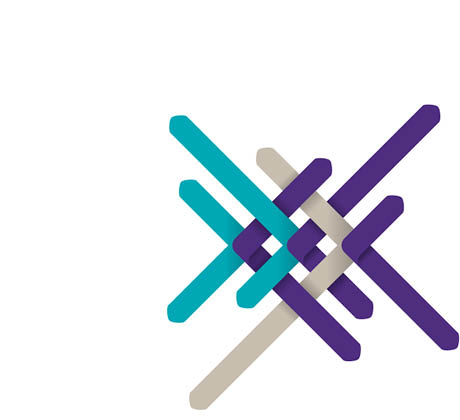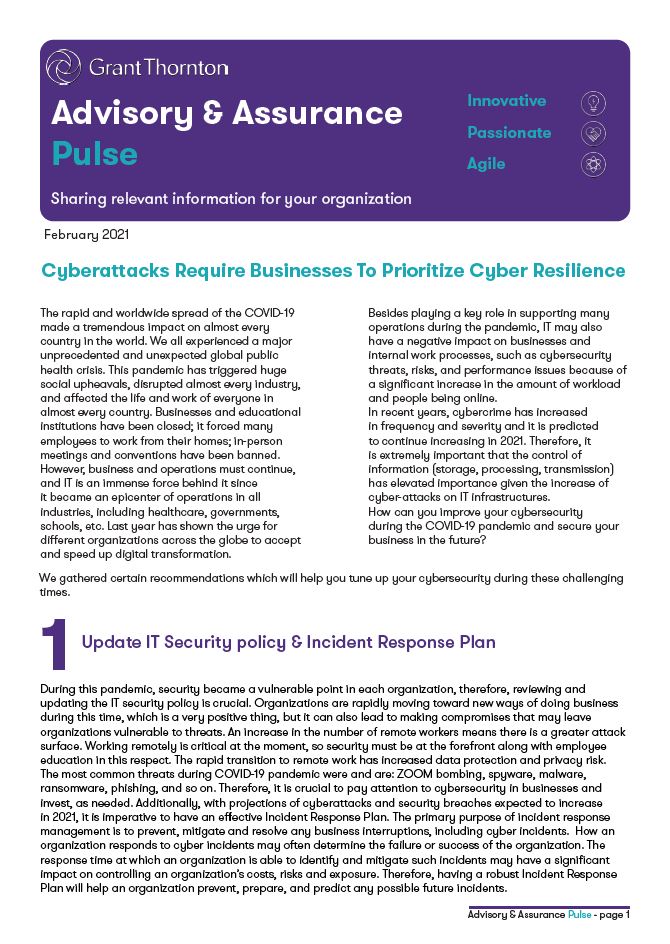-
Business Consulting
Our team ensures rapid response times, a low partner-to-staff ratio and is committed to delivering consistently high quality. Our business consulting services include naming a few: Governance, Risk, and Compliance, Business Transformation, Data Analytics, Human Capital, Operations Improvement, Program Management, Strategy & Innovation, Technology-enabled services, etc.
-
Business Risk Services
We deliver practical, pragmatic, and tailored solutions that support you in growing and protecting the value of your businesses. Our business risk services include naming a few: Enterprise Risk Management, Internal Audit, Operational Audit, Compliance Framework Solutions, Regulatory Compliance, Finance Risk and Modeling, Special Attestation Services, and Technology Risk Services. Are you looking into certifying your organization for best-practice management systems? We also offer gap assessments, implementation plans and managed services for ISO9001, ISO27001/2, ISO22301, and ISO37000, amongst many others.
-
IT, Cyber, Information Security & Privacy Services
Our highly skilled and experienced professionals are prepared to help you navigate the complex and dynamic digital environment you operate in. Our Cyber & Information Security solutions include amongst others: IT Audit and IT Strategy, Cyber Security Audit and Assessments, Cyber Strategy Solutions, Vulnerability Assessment and Penetration Testing, and Information Security & Privacy Frameworks (best practice) solutions.
-
Corporate Finance
For the past years, our highly experienced consultants have been dedicated to delivering a comprehensive array of services including transactions, valuations, deal advisory, and restructuring.
-
SHIELD - Technology Enabled Business Risk Services
With the launch of our brand-new operations center in Suriname, we offer managed services for (e.g.) risk and quality, regulatory compliance, cyber security, information security, privacy, business processes, financial Management and many more.
-
Financial Statement Audits
Our team of experienced auditors guarantee that the information presented in your financial statements is accurate and in accordance with prevailing accounting standards and company laws.
-
Financial Statement Reviews
Accuracy, compliance, and reliability. Our experienced auditors conduct a thorough examination, identifying errors and providing valuable recommendations to enhance reporting practices and internal controls.
-
Internal Audit Services
We analyze and pinpoint opportunities for enhancement, manage potential risks, and optimize operational efficiency, ensuring that you can confidently reach your business goals.
-
Data Assurance
Rely on our proficient team to conduct thorough evaluations, detect weaknesses, and establish resilient safeguards against data breaches, unauthorized access, and data manipulation. Our data assurance solutions are designed to protect your valuable information, ensuring its integrity, and fostering trust in your information systems.
-
Regulatory Compliance Services
Our Regulatory Compliance Services help you navigate complex regulatory landscapes and ensure adherence to applicable laws and regulations.
-
Compilation and preparation of financial statements
Our expert team delivers comprehensive reports that provide valuable insights for informed decision-making and regulatory compliance.
-
Bookkeeping and financial accounting
From managing financial records to preparing accurate reports, we ensure compliance, transparency, and sound financial management.
-
Payroll compliance and administration
At Grant Thornton, we meet the challenges of our clients. Our offering is tailored to meet all your payroll requirements through a single point of contact. Our outsourced payroll team becomes your dedicated payroll department, aiming to process your payroll in the most cost effective and compliant manner.
-
Business services and outsourcing
Our reliable and cost-effective outsourcing services help you streamline your business operations by taking care of your workload.
-
Tax Advice and Wealth Planning for high-net worth individuals
Our team of experienced tax advisors blend commercial experience and knowledge with tax expertise to advise on the full range of transactions including sales, mergers, restructurings, and wealth planning.
-
Tax Compliance
We prepare tax returns, for example for profit tax returns, personal income tax, wage tax and turnover tax/ sales tax. Our expert team handles all aspects of tax preparation and filing while keeping you informed of deadlines and minimizing the risk of penalties.
-
(International) tax planning and incorporation services
Experience the perfect combination of tax planning and incorporation services in one comprehensive package. Our team of experts strategically minimize your tax liabilities while ensuring compliance with regulations. Additionally, we provide guidance and support throughout the entire incorporation process, offering valuable insights on legal structures, registration, and tax implications.
-
Advice on estate and retirement planning
Secure your financial future with our dedicated estate and retirement tax planning service. Our experienced team specializes in developing tailored strategies to minimize tax liabilities, protect your assets, and optimize retirement income. Count on us to navigate intricate tax laws, ensuring peace of mind and financial security for your future.
-
Advice on investing on the islands
Embark on a journey towards financial growth with our comprehensive investment advice service. Our advisors know and remain up-to-date wit the market trends on the islands in the Dutch Caribbean region. Evaluate your risk tolerance and craft personalized investment strategies tailored to your goals.
The rapid and worldwide spread of the COVID-19 made a tremendous impact on almost every country in the world. We all experienced a major unprecedented and unexpected global public health crisis. This pandemic has triggered huge social upheavals, disrupted almost every industry, and affected the life and work of everyone in almost every country. Businesses and educational institutions have been closed; it forced many employees to work from their homes; in-person meetings and conventions have been banned.
However, business and operations must continue, and IT is an immense force behind it since it became an epicenter of operations in all industries, including healthcare, governments, schools, etc. Last year has shown the urge for different organizations across the globe to accept and speed up digital transformation.
Besides playing a key role in supporting many operations during the pandemic, IT may also have a negative impact on businesses and internal work processes, such as cybersecurity threats, risks, and performance issues because of a significant increase in the amount of workload and people being online. In recent years, cybercrime has increased in frequency and severity and it is predicted to continue increasing in 2021. Therefore, it is extremely important that the control of information (storage, processing, transmission) has elevated importance given the increase of cyber-attacks on IT infrastructures. How can you improve your cybersecurity during the COVID-19 pandemic and secure your business in the future?
We gathered certain recommendations which will help you tune up your cybersecurity during these challenging times.
1 Update IT Security policy & Incident Response Plan
During this pandemic, security became a vulnerable point in each organization, therefore, reviewing and updating the IT security policy is crucial. Organizations are rapidly moving toward new ways of doing business during this time, which is a very positive thing, but it can also lead to making compromises that may leave organizations vulnerable to threats. An increase in the number of remote workers means there is a greater attack surface. Working remotely is critical at the moment, so security must be at the forefront along with employee education in this respect. The rapid transition to remote work has increased data protection and privacy risk. The most common threats during COVID-19 pandemic were and are: ZOOM bombing, spyware, malware, ransomware, phishing, and so on. Therefore, it is crucial to pay attention to cybersecurity in businesses and invest, as needed. Additionally, with projections of cyberattacks and security breaches expected to increase in 2021, it is imperative to have an effective Incident Response Plan. The primary purpose of incident response management is to prevent, mitigate and resolve any business interruptions, including cyber incidents. How an organization responds to cyber incidents may often determine the failure or success of the organization. The response time at which an organization is able to identify and mitigate such incidents may have a significant impact on controlling an organization’s costs, risks and exposure. Therefore, having a robust Incident Response Plan will help an organization prevent, prepare, and predict any possible future incidents.
2 Deployment of the right technologies
A CEO of a large tech company recently stated, “We are witnessing what will surely be remembered as a historic deployment of remote work and digital access to services across every domain.” What is important during this ‘historical’ deployment is to ensure that suitable technologies are deployed and are not bringing any damage to the business and its customers. In the age where organizations are moving to cloud solutions such as DropBox, and /or outsourcing IT activities, the danger is to think that security and data privacy are “someone else’s problem”. Now is the time for organizations to identify what cloud systems and infrastructure their employees are using and ensure it is clear who is responsible for securing and monitoring their data. Organizations should implement privacy-by-design and data-segmentation policies, so they have insight and control over who has access to their data in both first- and third-party environments. Additionally, many organizations are using Virtual Private Networks (VPNs) to connect securely, however the majority of these organizations are using VPNs from major manufacturers that have some vulnerabilities which are easily exploited. These vulnerabilities have not been patched as of yet and may pose a major risk for security breaches.
3 Promoting of Cyber hygiene
Cyber hygiene should always be a part of the daily routine, and now during challenging times, it is highly important. Since the start of the pandemic, there have been reports of scams impersonating public authorities such as governmental institutions and schools, who are offering credits, financial support and so on.
Some tips how to maintain hygiene in your organizations:
- Implement multi-factor authentication for all your organization’s devices. Multi-factor authentication (MFA) adds an additional layer of security and is a major part of a strong authentication and access management policy which drastically decreases chances of cyber-attacks. In addition to MFA, organizations should ensure that log in credentials on devices enforces strong passwords.
- Provide frequent cybersecurity awareness training to employees. One of the top culprits of cyber-attacks is social engineering which is due to the lack of employee trainings and cybersecurity knowledge. Organizations need to invest in regular training for their employees in order to fully address cybersecurity threats. Trainings will help in adding another layer of protection for the organization’s sensitive data.
- Regularly updating software is essential. Always being up to date with software patches ensures that employees are working with the latest software which have eliminated or patched possible security issues, software flaws and glitches.
- Perform data back-ups regularly. An organization must ensure that data backups are performed regularly or in real time and stored in an external or separate environment. Such environments may include but not limited to external hard drive or the cloud. This can help protect against many types of data loss, especially if hackers gain access to one of the organization’s devices.
We hope you find this information helpful in giving you some insights for your organization. If you would like to discuss any of the points above, get in touch with your local Grant Thornton contact or email us via info@aw.gt.com

